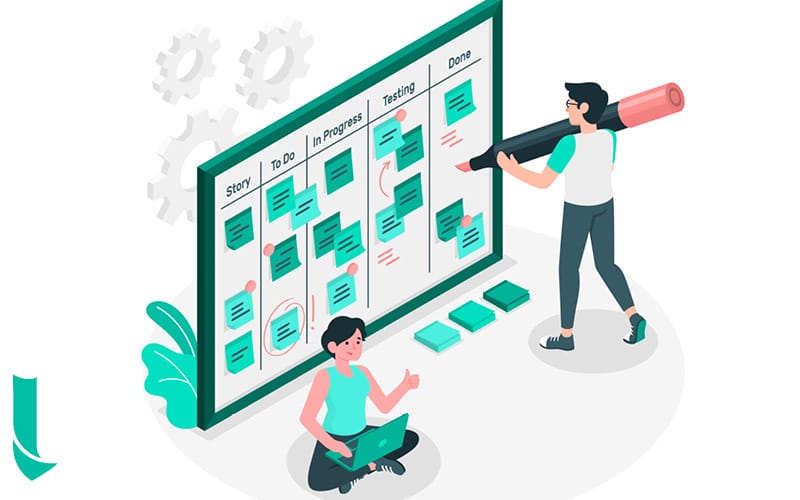THE PRODUCT BACKLOG: FOUNDATION OF AGILE MANAGEMENT

The product backlog is a central element in Agile project management, particularly in the Scrum method. It is a planning and prioritization tool that allows the development team to focus on high-value items.
What is a Product Backlog?
The product backlog is an ordered list of all the features, improvements, bug fixes, and other work items needed to complete a product. These items, known as "items" or "user stories," are described in terms of both functional and non-functional requirements, with enough detail to allow the team to understand and implement them.
Characteristics
- Dynamic: The product backlog is a living document. It evolves based on user feedback, changes in priorities, and new ideas. It is continuously updated throughout the project’s lifecycle.
- Prioritized: The items in the product backlog are ranked in order of priority, with the most important ones at the top of the list. This allows the team to focus on what brings the most value to the product.
- Transparent: The backlog is accessible to all team members and stakeholders. Everyone can see what is planned, what is in progress, and what has been completed.
- Estimated: Items at the top of the backlog are usually estimated in terms of complexity or time needed to complete them. This helps with sprint planning and delivery timelines. However, not every item in the backlog is estimated, as estimation depends on the maturity of the topic. The team refines and estimates the items that will be worked on soon, while newly added items often lack details and therefore aren't estimated by the team.
Usage
The product backlog serves as the basis for sprint planning and guides the work of the team. Here’s how it is typically used in an Agile framework:
- Sprint Planning: During the planning of each sprint, the team selects the items from the top of the product backlog. These items are the highest priority and bring the most value in the short term.
- Review and Refinement: The product backlog is regularly reviewed and refined during specific meetings called "backlog refinement." The goal is to add details, clarify requirements, re-evaluate priorities, and estimate new tasks.
- Progress Tracking: The product backlog also serves as a tracking tool. As items are completed, they are marked as "Done," allowing the team and stakeholders to visualize progress.
- Communication: The product backlog facilitates communication between the development team, the Product Owner, and other stakeholders. It helps align everyone on the product’s goals and priorities.
How to Organize Your Product Backlog?
Effective management of the product backlog is crucial for ensuring the success of an Agile project. Here are some common practices for managing and organizing the backlog:
- Continuous Prioritization: The Product Owner is responsible for prioritizing items in the product backlog. The most critical items should always be at the top of the list. This prioritization is based on value to the customer, technical complexity, risks, and timelines.
- Regular Refinement: The product backlog should be regularly refined to ensure that the items are ready to be worked on. This involves detailing user stories, adjusting priorities, and estimating the necessary efforts.
- Breaking Down Items: Large items (called "epics") should be broken down into smaller, more manageable user stories. This makes them easier to understand, estimate, and implement.
- Using Acceptance Criteria: Each item in the backlog should have clear acceptance criteria. These criteria define the conditions that must be met for the item to be considered complete and meet expectations.
- Maintaining Clarity and Simplicity: The product backlog should be clear and simple to understand. Avoid overly technical or complex descriptions, and ensure that every team member can easily grasp the content of each item.
- Avoiding Backlog Inflation: The backlog should not become an endless list of ideas. It’s important to regularly clean the backlog by removing or archiving obsolete or irrelevant items.
Best Practices for Backlog Tracking
- Recurring Refinement Meetings: Organize regular backlog refinement meetings (e.g., once per sprint) to keep the backlog up-to-date and relevant.
- Using Collaborative Tools: Use project management tools like Jira to manage the product backlog. These tools offer tracking, collaboration, and reporting features that make managing the backlog easier.
- Involving Stakeholders: Involve stakeholders in the refinement and prioritization process. Their feedback is essential to ensure that the backlog reflects the real needs of the customer.
- Measuring Progress: Use indicators like the "burn-down chart" or the "burn-up chart" to track progress and adjust plans accordingly.
- Focus on Added Value: Focus on the items that bring the most value to the product and the end user. The backlog should always reflect what is most important for the success of the product.
Conclusion
The product backlog is a pillar of Agile project management. When well-managed, it enables prioritization of work, ensures transparency, and delivers high-quality products. By following good backlog management practices, teams can ensure that their work stays aligned with project goals and user expectations. A well-organized product backlog is essential for success in an Agile environment, where rapid adaptation to change and continuous delivery of value are crucial.
